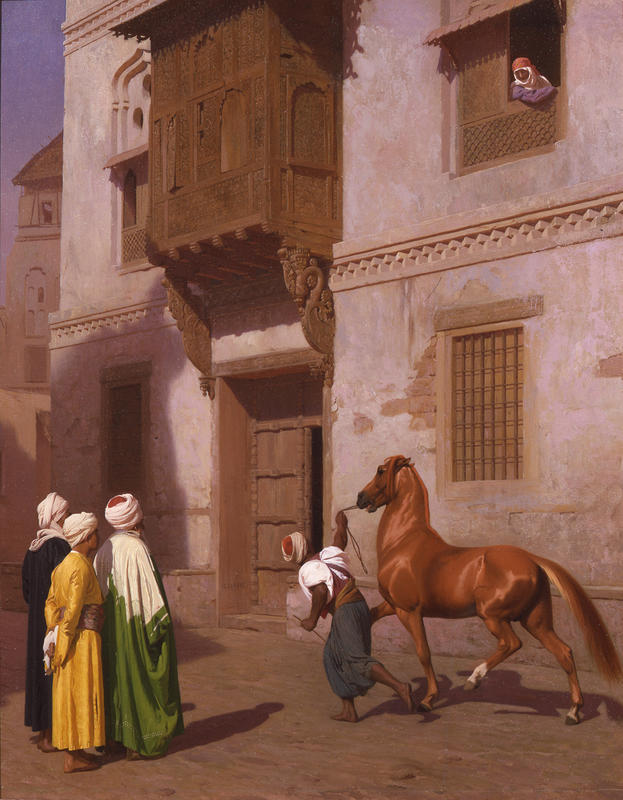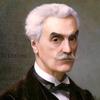More about The Horse Market

Sr. Contributor
A 19th century painting of a horse market, whether in America or Europe, was not an unusual thing to see.
Rosa Bonheur painted at least one, The Horse Fair, Edwin Lord Weeks did Horse Market, Persian Stables, Bombay, Alexander von Bensa painted Horse Market near Debreczin, and of course, our man Jean-Léon Gérôme. Many of the horse market paintings were created during a time when Orientalism was very popular in Europe and were often set in what were thought of as exotic locations, such as Cairo or the Ottoman Empire, for example.
Gerome was known mainly for two things regarding his art: nude women and “Orientalist” scenes. He was able to combine these two favorites of his in many of his works, but he also created scenes that were meant to depict daily life in places such as Egypt, which is where The Horse Market (also known as Cairene Horse Dealer) is supposed to be located. Gerome was an expert at including a lot of details in his work, even if they weren’t perfectly accurate. One such detail in The Horse Market relates to the window lattice; it’s been noted that the style is not Egyptian, but maybe Indonesian or Indian.
The building that Gerome based this painting on was actually in Moka, Yemen. He traveled to Alexandria, Egypt, with Frederic Auguste Bartholdi, then a student at the Ecole des Beaux-Arts, in what would be one his many trips to the area. Bartholdi would continue his trip by traveling on to “Arabia Felix” (Yemen), while Gerome chose not to join him. Bartholdi was an aspiring sculptor, but he also dabbled in photography, and at least a couple of the photographs that he took in Yemen were used by Gerome in his work. For The Horse Market, Gerome combined two photos, one of the main building, and one of the building in the background, this one in Hodeidah, also in Yemen.
Luckily for Gerome, nobody would be questioning the architectural accuracy of the buildings in the painting; most people would never know the difference, and to be honest - I wouldn’t either. He may have chosen to use the Yemeni building as a model simply because his friend had taken a nice, clear photo of it that he could use back in his studio, or maybe he just hadn’t found anything to his liking in Cairo.
The horse that is being trotted out for the potential buyers has no saddle, blanket, or accessories apart from the bit he is being led by. What this horse does have, though, is what looks to be a dyed and “styled” mane; Gerome also used this detail on the horse in The Saddle Bazaar, Cairo. It was a fairly common practice to use henna to tart up a horse for a celebration or to denote the status of the owner. In this case, it seems a little out of place, but maybe Gerome simply wanted to add a little more color to the scene.
Sources
- Ackerman, Gerald M. The Life and Work of Jean-Léon Gérôme: With a Catalogue Raisonne. London: P. Wilson, 1986.
- Cars, Laurence Des, Font-Réaulx Dominique de, and Papet Édouard. The Spectacular Art of Jean-léon Gérôme (1824-1904). Milan: Skira, 2010.
- Kip, Brint, G. (2017, July 28). Henna for horses: Ancient decorative and medicinal traditions. Kip Mistral. https://www.kipmistral.com/henna-for-horses-ancient-decorative-and-medi…
- Sanders, Patricia B. The Haggin Collection. Stockton, CA: Haggin Museum, 1991.
- Skenderovic, Damir, and Christina Späti. “From Orientalism to Islamophobia: Reflections, Confirmations, and Reservations.” ReOrient 4, no. 2 (2019): 130–43. https://doi.org/10.13169/reorient.4.2.0130.
- The Equinest. “The Horses of Jean-Léon Gérôme.” The Equinest, July 6, 2011. http://www.theequinest.com/jean-leon-gerome/.











